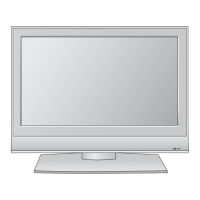
Do you have a question about the LG 32LC4R and is the answer not in the manual?
| Screen Size | 32 inches |
|---|---|
| Display Type | LCD |
| Resolution | 1366 x 768 |
| Aspect Ratio | 16:9 |
| Brightness | 500 cd/m² |
| Response Time | 8 ms |
| HDMI Ports | 2 |
| Viewing Angle | 178° |
| Component Video Input | 1 |
| S-Video Input | 1 |
| Composite Video Input | 1 |
| TV Tuner | Analog |
| Power Consumption | 150W |
| Inputs | HDMI, Component, S-Video, Composite, PC, RF |
| PC Input | 1 (D-Sub) |
General safety guidelines for servicing to prevent hazards.
Procedures for performing cold and hot AC leakage current checks on the chassis.
Essential safety rules for servicing, including power, voltage, cleaning, and handling.
Procedures for handling sensitive electronic components to prevent static discharge damage.
Best practices for soldering components and circuit boards, including tools and techniques.
Methods for removing and replacing ICs, transistors, diodes, and fuses.
Technique for repairing damaged copper patterns on printed circuit boards using jumper wires.
Defines the application range and required conditions for product testing.
Provides detailed specifications for the LCD module, including dimensions and backlighting.
Details specifications for component, RGB analog PC, and HDMI digital inputs.
Defines the application range and specifications for adjustment procedures.
Step-by-step guide for adjusting PCB assemblies using VCTP download.
Procedure for downloading software to PCB assemblies using the VCTP program.
Procedure for downloading firmware to AV plate assemblies.
Procedure for updating channel memory data using the Channel.vi2c program.
Procedure to change tool and area options before PCBA check for correct model settings.
Inspection process for color carrier adjustment, involving RF tuning and remote control input.
Guidelines and methods for downloading EDID and DDC data using specific cables and software.
Steps for connecting equipment and configuring software for EDID data writing.
Detailed procedure for adjusting white balance using manual and automatic methods.
Procedure for inputting the correct option number into the shipping area as specified in the BOM.
Displays default white balance values and outlines internal press test and sound specifications.
Guides through diagnosing and resolving no-power issues by checking connections and fuses.
Troubleshooting steps for no OSD or image display, checking modules and connections.
Diagnosing unusual display issues in RF mode by checking video output, cables, and I2C communication.
Troubleshooting unusual displays in rear AV, Side AV, and Side S-Video modes by checking input sources.
Troubleshooting display issues in SCART 1 and SCART 2 modes by checking input sources.
Troubleshooting display problems in Component and RGB modes by checking input sources.
Diagnoses no sound problems by checking speaker settings, cable integrity, and audio IC output.
Troubleshoots HDMI video and audio problems by checking EDID data, TMDS waves, and registers.
Provides a high-level overview of the TV's system architecture and interconnections.
Provides a visual breakdown of the TV's physical components and their assembly.
Lists part numbers and descriptions for components shown in the exploded view.
Shows detailed diagrams for SCART inputs and the video decoder section.
Illustrates the VCTP chip block and the main tuner circuitry.
Displays detailed diagrams for HDMI input, analog inputs, and audio circuits.
Shows detailed diagrams for Panel LVDS interface and power supply systems.